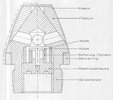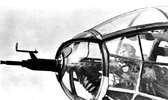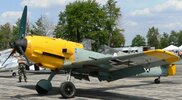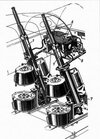pzgr40
Well-Known Member
Cutaway models of 20x81 MG/FF cartridges. The Oerlikon MG/FF automatic cannon was designed in 1936 by the Ikaria Werke in Berlin, and was derived from the Becker 20mm gun from the First World War. The cannon was designed with the purpose that it could be placed in small spaces, such as airplane wings. The term MG/FF stands for 'Machine Gewehr / Flugel Fest' which means fixed wing mounting machine gun.
From 1941 onward, the 20x81 MG/FF was slowly phased out and replaced by the Mauser 20x81 MG 151/20, which had a higher rate of fire as well as a higher muzzle velocity.
The MG/FF gun was 1.37 meters long and weighed 26.3 kg. One of the disadvantages of using the M shell (Minengeschoss) was that it was lighter than the high-explosive, incendiary and armor-piercing shells, and since the MG/FF was a blowback weapon, this caused weapon failures in combined belts. For this reason, an MG/FF was modified for shooting M-shells with a lighter recoil spring. This weapon was referred to as the 20mm MG/FF/M. However, heavier grenades were not allowed to be fired from this weapon as this would damage the weapon.
The 20x81 MF/FF (/M) automatic cannon was used in the following aircraft; the Me-109E3 to F1 models (wings), the Fw-190A1 to A5 models, the Me-110 C to F models as well as upward firing cannons (schrage musik) built into the fuselage of the Me-110 night fighter. The cannon was built into bombers as a crew served aircraft defence weapon in the He-111 and the Do-17.
A disadvantage of the wing-mounted guns of the Me-109 was the limited ammunition capacity, the cartridges were supplied from a drum magazine with 60 cartridges, which with a firing rate of 530 rounds per minute meant that there was only 9 seconds of firing time. The Fw-A5 used a 90 round drum magazine, which provided a marginal improvement to 13 seconds of firing time. Since the 20mm MG-151/20 had a belt feed with 125 rounds, the 20mm MG/FF was slowly replaced by the 20mm MG-151/20.
Cutaway model 01
2cm Brandsprenggranatpatrone Leuchtspur FFM mit zerleger, 2cm High explosive incendiary shell FFM with tracer self destruct.
Projecile weight: 115 grams.
Filling: 2.3 grams of Nitropenta (pink) and 2.1 grams of Elektronthermit incendiary mixture (gray).
Fuze: AZ 1501 (nose fuze), under which a Duplex detonator is screwed.
Tracer length: approximately 1200 meters, self-destruct after 1200 meters.
Vo: 585 meters/sec.
Shellcase length: 81 mm.
Shellcase material: brass.
Powder charge: 13.2 grams of Nz Bl.P (Nitrocellulose Leaf Powder).
Cartridge weight: 183 grams.
Effect: Splinter- and incendiary effect.
Projectile color: yellow with a red band above the driving band (day tracer) or a dark red band (dim tracer/glimspur), and a green band just below the nose fuze, indicating that the projectile has a self-destruct mechanism.
The difference between Leuchtspur (tracer) and Glimmspur (dim tracer) is that tracers are used during daytime, and dim tracers at night. Dim tracers are less bright and this prevented the pilot whose eyes were used to the dark from being temporary blinded by tracers. When used during the daytime, dim tracers are barely to not visible at all.
The brass AZ 1501 is the first type of nose fuze used on the high-explosive grenade. The firing pin is blocked by a safety slide with a chamfered edge, held in the safe position by a vertical pin that is fixed in the upward position under the chamfered edge by a pellet of black powder. Sideways there are two primers placed above two firing pins which are kept away from the firing pins by a spring. When the shot is fired, the primers move backwards - due to the inertia effect - into the firing pins and ignite. The black powder pellet below the vertical pin is ignited through drilled channels and then burns away. The safety slide is thrown outwards by the centrifugal force and pushes the vertical pin down through with the chamfered edge. The firing pin is now free to move in the duplex detonator upon impact with the target. After 1942, the AZ 1501 is no longer mentioned in the German pamphlets.
If no target is hit, the brass container with the self-destruct charge (black) placed in the incendiary charge (gray) will ignite after the tracer has burned out and grenade will self destruct.
Cutaway model 02
2cm Brandsprenggranatpatrone Leuchtspur FFM mit zerleger, 2cm High explosive incendiary shell FFM with tracer self destruct.
Shell weight: 115 grams.
Filling: 2.3 grams of Nitropenta (pink) and 2.1 grams of Elektronthermit incendiary mixture (gray).
Fuze: AZ 1504 (nose fuze), under which a Duplex detonator is screwed.
Tracer length: approximately 1200 meters, self-destruct after 1200 meters.
Vo: 585 meters/sec.
Shellcase length: 81 mm.
Shellcase material : brass.
Powder charge: 13.2 grams of Nz Bl.P (Nitrocellulose Leaf Powder).
Cartridge weight: 183 grams.
Effect: splinter and incendiary effect.
Projectile color: yellow with a red band above the driving band (day tracer) or a dark red band (night tracer/glimspur) and a green band just below the nose fuze indicating that the grenade has a self-destruct mechanism.
The aluminum AZ 1504 is the successor to the AZ 1501. The fuze body (3) is fully aluminum made. A steel firing pin (5) is positioned sideways, out of alignment with the duplex detonator and cannot strike it when safe, because a steel ball (10) rests above the hole above the duplex detonator. The firing pin (5) is placed in a kind of 'yoke-shaped' magnesium safety slide (4) with a recess for the steel ball in the base. From the bottom of the lower part of the fuze body, a hole has been drilled in the longitudinal direction that extends outwards at an angle of two degrees - viewed upwards-. Two radially placed steel pins (6) are placed under the safety slide that prevent the ball from moving upwards when safe. These two pins are held in the inner position by a band spring (7). After the shell is fired, the two pins (6) move outward due to the centrifugal force, and the steel ball (10) starts to climb up against the sloping side of the hole through the centrifugal force after acceleration decreases until it enters the recess in the bottom of the safety slide (4). As a result, the safety slide suddenly becomes heavier on this side and is thrown outwards, the firing pin being slided above the duplex capsule. Upon impact, the striking pin (2) pushes the firing pin (5) in the duplex detonator, causing the shell to explode.
If no target is hit, the brass container with the self-destruct charge (black) placed in the incendiary charge (gray) will be ignited by the tracer after the tracer burns out and destroy the shell.
Cutaway model 03
2cm Brandsprenggranatpatrone Leuchtspur FFM ohne zerleger, 2cm High explosive incendiary shell FFM without tracer self destruct.
Projectile weight: 115 grams.
Filling: 2.3 grams of Nitropenta (pink) and 2.1 grams of Elektronthermit incendiary mixture (gray).
Fuze: AZ 1504 (nose fuze), under which a Duplex detonator is screwed.
Tracer length: approximately 1200 meters
Vo: 585 meters/sec.
Shellcase length: 81 mm.
Shellcase material: brass.
Powder charge: 13.2 grams of Nz Bl.P (Nitrocellulose Leaf Powder).
Cartridge weight: 183 grams.
Effect: splinter and incendiary effect.
Projectile color: yellow with a red band above the driving band (tracer) or a dark red band (dim tracer).
Cutaway model 04
2cm sprengranatpatrone Ub FFM ohne zerleger, 2cm practice high explosive shell FFM without self destruct.
Projecile weight: 115 grams.
Filling: none.
Fuze : none.
Tracer length : none
Vo: 585 meters/sec.
Shellcase length: 81 mm.
Shellcase material: brass.
Powder charge: 13.3 grams of Nz Bl.P (Nitrocellulose Leaf Powder).
Cartridge weight: 183 grams.
Effect: none.
Projectile color: gray.
Cutaway model 05
2cm Sprenggranatpatrone L’spur Ub FFM mit zerleger, 2cm practice high explosive shell FFM with tracer self destruct.
Projectile weight: 115 grams.
Filling: Nitropenta with black powder ignition charge by means of a tracer self-destructor. Above the Nitropenta charge a Bakelite filler piece is placed.
Fuze: dummy nose fuze.
Tracer length: 650 meters.
Vo: 585 meters/sec.
Shellcase length: 81 mm.
Shellcase material: brass.
Powder charge: 13.3 grams of Nz Bl.P (Nitrocellulose Leaf Powder).
Cartridge weight: 183 grams.
Effect: none, intended for exercises with a limited shooting range.
Projectile color: gray with red band just above the guide band and a green band just below the dummy fuze fuze.
Cutaway model 06
Sprenggranatpatrone L’spur Ub FFM ohne zerleger, 2cm practice high explosive shell FFM without tracer self destruct.
Projectile weight: 115 grams.
Filling: none.
Fuze: dummy nose fuze.
Tracer length: 650 meters.
Vo: 585 meters/sec.
Shellcase length: 81 mm.
Shellcase material: brown muffled steel.
Powder charge: 13.3 grams of Nz Bl.P (Nitrocellulose Leaf Powder).
Cartridge weight: 183 grams.
Effect: none, intended for practice firing.
Projectile color: gray with a red band just above the driving band.
From 1941 onward, the 20x81 MG/FF was slowly phased out and replaced by the Mauser 20x81 MG 151/20, which had a higher rate of fire as well as a higher muzzle velocity.
The MG/FF gun was 1.37 meters long and weighed 26.3 kg. One of the disadvantages of using the M shell (Minengeschoss) was that it was lighter than the high-explosive, incendiary and armor-piercing shells, and since the MG/FF was a blowback weapon, this caused weapon failures in combined belts. For this reason, an MG/FF was modified for shooting M-shells with a lighter recoil spring. This weapon was referred to as the 20mm MG/FF/M. However, heavier grenades were not allowed to be fired from this weapon as this would damage the weapon.
The 20x81 MF/FF (/M) automatic cannon was used in the following aircraft; the Me-109E3 to F1 models (wings), the Fw-190A1 to A5 models, the Me-110 C to F models as well as upward firing cannons (schrage musik) built into the fuselage of the Me-110 night fighter. The cannon was built into bombers as a crew served aircraft defence weapon in the He-111 and the Do-17.
A disadvantage of the wing-mounted guns of the Me-109 was the limited ammunition capacity, the cartridges were supplied from a drum magazine with 60 cartridges, which with a firing rate of 530 rounds per minute meant that there was only 9 seconds of firing time. The Fw-A5 used a 90 round drum magazine, which provided a marginal improvement to 13 seconds of firing time. Since the 20mm MG-151/20 had a belt feed with 125 rounds, the 20mm MG/FF was slowly replaced by the 20mm MG-151/20.
Cutaway model 01
2cm Brandsprenggranatpatrone Leuchtspur FFM mit zerleger, 2cm High explosive incendiary shell FFM with tracer self destruct.
Projecile weight: 115 grams.
Filling: 2.3 grams of Nitropenta (pink) and 2.1 grams of Elektronthermit incendiary mixture (gray).
Fuze: AZ 1501 (nose fuze), under which a Duplex detonator is screwed.
Tracer length: approximately 1200 meters, self-destruct after 1200 meters.
Vo: 585 meters/sec.
Shellcase length: 81 mm.
Shellcase material: brass.
Powder charge: 13.2 grams of Nz Bl.P (Nitrocellulose Leaf Powder).
Cartridge weight: 183 grams.
Effect: Splinter- and incendiary effect.
Projectile color: yellow with a red band above the driving band (day tracer) or a dark red band (dim tracer/glimspur), and a green band just below the nose fuze, indicating that the projectile has a self-destruct mechanism.
The difference between Leuchtspur (tracer) and Glimmspur (dim tracer) is that tracers are used during daytime, and dim tracers at night. Dim tracers are less bright and this prevented the pilot whose eyes were used to the dark from being temporary blinded by tracers. When used during the daytime, dim tracers are barely to not visible at all.
The brass AZ 1501 is the first type of nose fuze used on the high-explosive grenade. The firing pin is blocked by a safety slide with a chamfered edge, held in the safe position by a vertical pin that is fixed in the upward position under the chamfered edge by a pellet of black powder. Sideways there are two primers placed above two firing pins which are kept away from the firing pins by a spring. When the shot is fired, the primers move backwards - due to the inertia effect - into the firing pins and ignite. The black powder pellet below the vertical pin is ignited through drilled channels and then burns away. The safety slide is thrown outwards by the centrifugal force and pushes the vertical pin down through with the chamfered edge. The firing pin is now free to move in the duplex detonator upon impact with the target. After 1942, the AZ 1501 is no longer mentioned in the German pamphlets.
If no target is hit, the brass container with the self-destruct charge (black) placed in the incendiary charge (gray) will ignite after the tracer has burned out and grenade will self destruct.
Cutaway model 02
2cm Brandsprenggranatpatrone Leuchtspur FFM mit zerleger, 2cm High explosive incendiary shell FFM with tracer self destruct.
Shell weight: 115 grams.
Filling: 2.3 grams of Nitropenta (pink) and 2.1 grams of Elektronthermit incendiary mixture (gray).
Fuze: AZ 1504 (nose fuze), under which a Duplex detonator is screwed.
Tracer length: approximately 1200 meters, self-destruct after 1200 meters.
Vo: 585 meters/sec.
Shellcase length: 81 mm.
Shellcase material : brass.
Powder charge: 13.2 grams of Nz Bl.P (Nitrocellulose Leaf Powder).
Cartridge weight: 183 grams.
Effect: splinter and incendiary effect.
Projectile color: yellow with a red band above the driving band (day tracer) or a dark red band (night tracer/glimspur) and a green band just below the nose fuze indicating that the grenade has a self-destruct mechanism.
The aluminum AZ 1504 is the successor to the AZ 1501. The fuze body (3) is fully aluminum made. A steel firing pin (5) is positioned sideways, out of alignment with the duplex detonator and cannot strike it when safe, because a steel ball (10) rests above the hole above the duplex detonator. The firing pin (5) is placed in a kind of 'yoke-shaped' magnesium safety slide (4) with a recess for the steel ball in the base. From the bottom of the lower part of the fuze body, a hole has been drilled in the longitudinal direction that extends outwards at an angle of two degrees - viewed upwards-. Two radially placed steel pins (6) are placed under the safety slide that prevent the ball from moving upwards when safe. These two pins are held in the inner position by a band spring (7). After the shell is fired, the two pins (6) move outward due to the centrifugal force, and the steel ball (10) starts to climb up against the sloping side of the hole through the centrifugal force after acceleration decreases until it enters the recess in the bottom of the safety slide (4). As a result, the safety slide suddenly becomes heavier on this side and is thrown outwards, the firing pin being slided above the duplex capsule. Upon impact, the striking pin (2) pushes the firing pin (5) in the duplex detonator, causing the shell to explode.
If no target is hit, the brass container with the self-destruct charge (black) placed in the incendiary charge (gray) will be ignited by the tracer after the tracer burns out and destroy the shell.
Cutaway model 03
2cm Brandsprenggranatpatrone Leuchtspur FFM ohne zerleger, 2cm High explosive incendiary shell FFM without tracer self destruct.
Projectile weight: 115 grams.
Filling: 2.3 grams of Nitropenta (pink) and 2.1 grams of Elektronthermit incendiary mixture (gray).
Fuze: AZ 1504 (nose fuze), under which a Duplex detonator is screwed.
Tracer length: approximately 1200 meters
Vo: 585 meters/sec.
Shellcase length: 81 mm.
Shellcase material: brass.
Powder charge: 13.2 grams of Nz Bl.P (Nitrocellulose Leaf Powder).
Cartridge weight: 183 grams.
Effect: splinter and incendiary effect.
Projectile color: yellow with a red band above the driving band (tracer) or a dark red band (dim tracer).
Cutaway model 04
2cm sprengranatpatrone Ub FFM ohne zerleger, 2cm practice high explosive shell FFM without self destruct.
Projecile weight: 115 grams.
Filling: none.
Fuze : none.
Tracer length : none
Vo: 585 meters/sec.
Shellcase length: 81 mm.
Shellcase material: brass.
Powder charge: 13.3 grams of Nz Bl.P (Nitrocellulose Leaf Powder).
Cartridge weight: 183 grams.
Effect: none.
Projectile color: gray.
Cutaway model 05
2cm Sprenggranatpatrone L’spur Ub FFM mit zerleger, 2cm practice high explosive shell FFM with tracer self destruct.
Projectile weight: 115 grams.
Filling: Nitropenta with black powder ignition charge by means of a tracer self-destructor. Above the Nitropenta charge a Bakelite filler piece is placed.
Fuze: dummy nose fuze.
Tracer length: 650 meters.
Vo: 585 meters/sec.
Shellcase length: 81 mm.
Shellcase material: brass.
Powder charge: 13.3 grams of Nz Bl.P (Nitrocellulose Leaf Powder).
Cartridge weight: 183 grams.
Effect: none, intended for exercises with a limited shooting range.
Projectile color: gray with red band just above the guide band and a green band just below the dummy fuze fuze.
Cutaway model 06
Sprenggranatpatrone L’spur Ub FFM ohne zerleger, 2cm practice high explosive shell FFM without tracer self destruct.
Projectile weight: 115 grams.
Filling: none.
Fuze: dummy nose fuze.
Tracer length: 650 meters.
Vo: 585 meters/sec.
Shellcase length: 81 mm.
Shellcase material: brown muffled steel.
Powder charge: 13.3 grams of Nz Bl.P (Nitrocellulose Leaf Powder).
Cartridge weight: 183 grams.
Effect: none, intended for practice firing.
Projectile color: gray with a red band just above the driving band.
Attachments
-
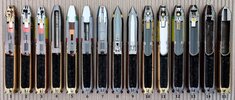 01 - 20x81 MG FF cartridges.jpg1.7 MB · Views: 82
01 - 20x81 MG FF cartridges.jpg1.7 MB · Views: 82 -
 02 - 20x81 MG FF gun.jpeg125.3 KB · Views: 77
02 - 20x81 MG FF gun.jpeg125.3 KB · Views: 77 -
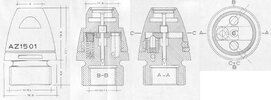 03 - AZ 1501.jpg921.7 KB · Views: 48
03 - AZ 1501.jpg921.7 KB · Views: 48 -
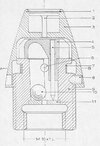 04 - AZ 1504.jpg245.1 KB · Views: 47
04 - AZ 1504.jpg245.1 KB · Views: 47 -
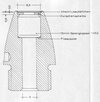 05 - AZ 1528.jpg235.4 KB · Views: 45
05 - AZ 1528.jpg235.4 KB · Views: 45 -
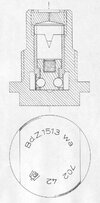 06 - BdZ 1513.jpg304.5 KB · Views: 45
06 - BdZ 1513.jpg304.5 KB · Views: 45 -
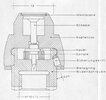 07 - AZ 1502.jpg243.8 KB · Views: 41
07 - AZ 1502.jpg243.8 KB · Views: 41 -
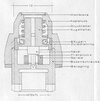 08 - ZZ 1505.jpg316 KB · Views: 75
08 - ZZ 1505.jpg316 KB · Views: 75
Last edited:

